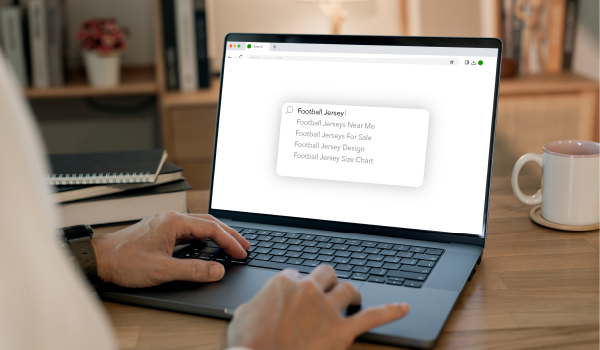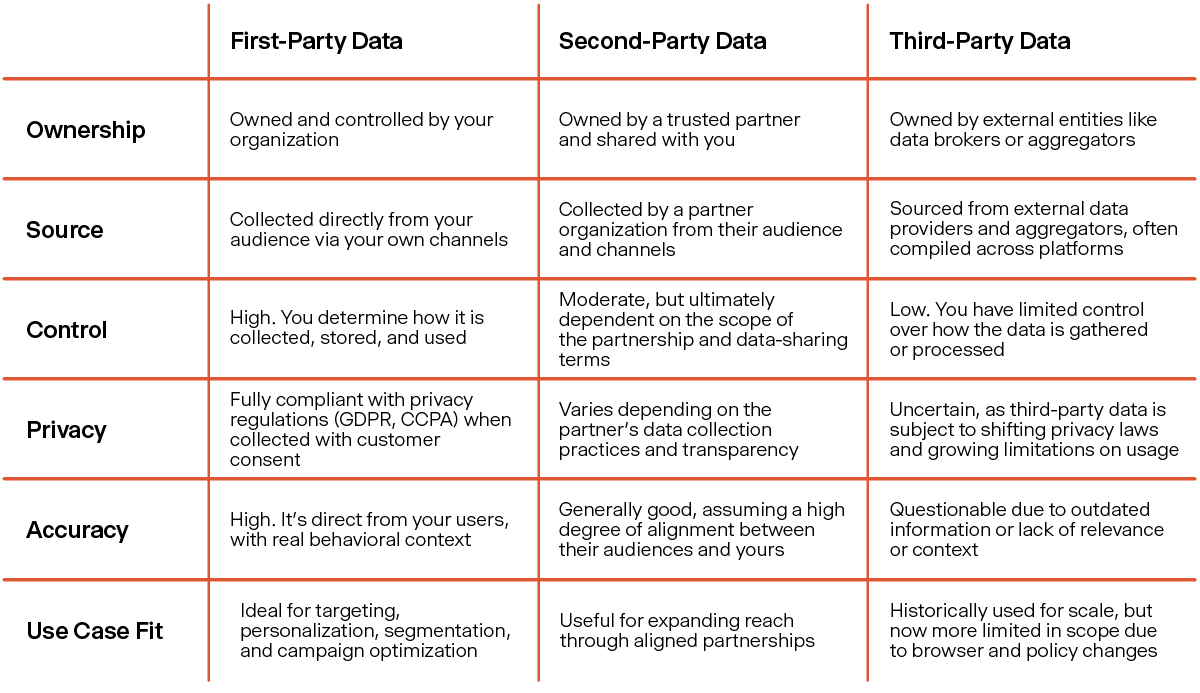How to Build a Winning First-Party Data Strategy for Advertising
Unlock privacy-first targeting, campaign precision, and future-ready ROI using your most valuable asset — your own data.
Writer: Luis Reyes
Date: September 11, 2025
If your brand is still relying on third-party data for targeting, it’s time to evolve. As third-party cookie tracking remains in flux and privacy regulations tighten, how you collect, manage, and activate customer data is more important than ever.

But it’s not just about compliance. Swapping broad, cookie-based targeting for consent-based strategies delivers better performance and deeper consumer trust. That’s why building a robust first-party data strategy is a competitive must-have for advertisers, brands, and agencies alike.
Not sure where to begin? In this guide, we’ll walk through what first-party data is, why it matters, and how to turn your data into personalized, privacy-safe advertising campaigns.
WHAT IS FIRST-PARTY DATA?
Let’s start with a clear first-party data definition. The term refers to any information that your company gathers directly from your audience through owned channels, such as websites, mobile apps, customer relationship management (CRM) systems, social media platforms, customer survey databases, and more.

There’s no borrowed, bought, or poorly aggregated information within first-party data, meaning it’s more accurate, relevant, and actionable than second or third-party strategies, which often combine insights gathered from multiple external sources with limited context.
HOW FIRST-PARTY DATA POWERS BETTER MARKETING & ADVERTISING
When you leverage first-party data, advertising and marketing teams can fine-tune targeting to deliver more creative, meaningful, and personalized marketing messages at scale. Here are a few ways to activate it:
- Website interactions: Every click, scroll, or product view on your website reveals something about user behavior. Even basic metrics, like knowing which pages receive the most traffic, help you prioritize content, highlight key offerings, and reshape targeting strategies.
- CRM systems: Your CRM provides valuable insights. For example, when you see a customer repeatedly buy a certain type of product, you can use that information to serve them cross-sell ads that align with their preferences.
- Loyalty programs: Points and reward systems help you understand buying frequency, brand affinity, and engagement over time. You can use this data to identify high-value customers and tailor your outreach to them, crafting exclusive promotions that enhance customer lifetime value (CLV).
- Email & SMS marketing: Opens, clicks, and opt-ins offer a window into intent. For instance, you can use the links clicked in a newsletter to retarget specific customers with dynamic product ads that match their interests.
- Surveys & customer feedback: Net Promoter Scores (NPS), post-purchase surveys, and user reviews provide direct, voice-of-customer insights. You can use responses to guide product improvements, inform messaging strategies, and uncover new audience segments.
With a clearer picture of who your customers are, what they want, and how they interact with your brand, you can stop guessing and start delivering campaigns that optimize performance across every channel.
FIRST-PARTY VS. SECOND-PARTY VS. THIRD-PARTY DATA: WHAT’S THE DIFFERENCE?
Not all data is created equal. For effective marketing, first-party data is key. However, it’s essential to remember that different data types serve different purposes. Before you can build a winning, future-ready data strategy, you need to understand the roles and potential of second-party and third-party data.
Each data type serves a distinct purpose:
- First-party data provides the most reliable, privacy-compliant foundation for personalized marketing. It comes directly from your audience through owned channels such as your website, app, CRM, or loyalty program. This data reflects real behavior and consent, which allows for accurate segmentation, stronger performance, and better long-term ROI.
- Second-party data helps you expand audience insights through trusted partnerships. This data is essentially another organization’s first-party data, shared with you through a mutual agreement. When aligned correctly, it can help you scale reach, enrich customer profiles, and uncover high-potential segments without sacrificing quality or transparency.
- Third-party data can offer broad-scale targeting options, but it should be used thoughtfully given evolving privacy regulations and the decline of cookie-based tracking. These audiences are often pre-packaged with limited visibility into how segments are constructed. For example, a tradesman shopping at a home improvement store might be grouped into the same “DIY shopper” segment as a parent and child buying gardening tools. The location is the same, but the intent is very different. This lack of clarity can make it harder to optimize campaigns without first-party insights to guide targeting.
Here’s a more detailed overview of how these three types of data compare:

Focus on maximizing your first-party data strategy and use second-party data to fill strategic gaps through trusted partners. When it comes to third-party data, it’s an option to consider to scale reach. If you choose to use it, make sure you partner with industry experts who fully understand the risks, limitations, and legal implications.
WHY FIRST-PARTY DATA COLLECTION IS ESSENTIAL IN A PRIVACY-FIRST WORLD
Today’s consumers expect brands to walk a fine line: deliver personalized, relevant experiences without compromising trust. And that expectation is reshaping the entire digital advertising ecosystem.
- 86% of consumers say data privacy is a growing concern (Source)
- 75% are more likely to buy from brands offering tailored experiences (Source)
Simultaneously, browser support for third‑party cookies remains fragmented, and regulations like GDPR, CCPA, and CPRA are redefining what responsible marketing looks like. As a result, leveraging a first-party data platform is no longer a “nice to have.” It’s the backbone of performance marketing in a privacy-first world.
Simpli.fi empowers advertisers to succeed in this new landscape with solutions built for precision, agility, and compliance:
- Adaptive targeting technology: Seamlessly switch between cookie-based and cookieless systems, so your campaigns remain precise and scalable, regardless of browser behavior.
- Consent-first activation: Built-in mechanisms ensure compliance with GDPR, CCPA, and APRA, powering trust-driven audience engagement.
- Real-time contextual intelligence: Beyond consent, Simpli.fi taps unstructured signals—like location or device usage—to deliver timely, relevant messages.
- Unified campaign control: Activate, manage, and optimize first-party, second-party, and responsibly sourced third-party data from a single, intuitive platform
Whether you’re running omnichannel campaigns across CTV, display, mobile, or video, Simpli.fi gives you the flexibility to adapt quickly while ensuring every impression meets your audience’s expectations and regulatory requirements.
HOW BRANDS USE FIRST-PARTY DATA FOR MARKETING & ADVERTISING
Wondering how to put a first-party data strategy to work across your channels? Here are some real-world examples to inspire your approach:
- Ad retargeting & lookalike audiences: You can re-engage prospects who viewed a product on your website but didn’t purchase by serving them a tailored offer. Meanwhile, you can identify similar browser profiles from your first-party audience segments and target them with introductory messaging to expand your reach.
- Predictive analytics & AI targeting: Powerful AI tools and machine learning algorithms help you analyze behavioral trends from first-party data to predict future actions. This will let you make data-driven insights into your media buying, reduce ad spend waste, and see higher conversion rates.
- Personalized email marketing: Direct-to-consumer (DTC) brands can leverage browsing behavior and purchase history to deliver customized emails featuring specific product recommendations, restock alerts, or loyalty incentives that boost engagement and drive repeat purchases.
- Loyalty & rewards programs: You can track frequency, spend level, and category preferences to identify valuable customers and create exclusive, micro-segmented campaigns that increase retention and maximize customer lifetime value while reinforcing brand affinity.
- Customer journey optimization: By mapping how users engage across multiple touchpoints—from initial ad to post-purchase survey —you can refine your messaging, eliminate friction, and build more cohesive brand experiences from start to finish.
Want more real-world insights? Check out our growing list of client case studies to learn how implementing effective first-party data strategies like keyword-level retargeting, geofencing, and addressable targeting can drive meaningful results.
7 STEPS TO BUILDING A FIRST-PARTY DATA STRATEGY THAT WORKS
A strong first-party data strategy starts with a clear plan. Here’s a step-by-step guide to help you collect, organize, and activate data effectively.
1. Define Data Collection Points & Consent Strategy
Start by mapping every touchpoint where your brand interacts with customers and where first-party data can be collected. These might include:
- Browsing behavior on your website
- Mobile app interactions (logins, push notifications, in-app purchases)
- CRM data, account activity, and support tickets
- Loyalty sign-ins and in-store behavior (via point-of-sale, Wi-Fi, kiosks)
- Email and SMS engagement
- Event registrations, webinar follow-ups, and surveys
- Social media lead forms or chat interactions
Next, implement clear, user-friendly consent mechanisms to ensure compliance with privacy regulations like GDPR, CCPA, and CPRA. This might include cookie banners, opt-in checkboxes, or contextual privacy notices.
2. Integrate First-Party Data with CDPs & CRM Systems
To unlock the full value of your data, it must be centralized and connected. Use a Customer Data Platform (CDP) or CRM system to unify data across channels and create persistent customer profiles.
Look for tools that support:
- Native integrations or APIs
- Tag management solutions
- ETL (Extract, Transform, Load) processes
- Real-time data syncing with ad platforms
Once integrated, this system becomes your source of truth, which supports consistent messaging and personalized segmentation.
3. Ensure Privacy Compliance & Data Governance
Data privacy is a legal requirement and a trust signal to your audience. Your strategy should include:
- Clear data use disclosures and opt-in records
- User-level controls for consent management
- Regular policy reviews and system audits
- Role-based access controls to secure sensitive data
Assign ownership of data governance internally or use a dedicated platform to automate these tasks. Simpli.fi’s privacy-first architecture helps advertisers stay compliant while activating data seamlessly across channels.
4. Leverage Identity Resolution for Cross-Channel Targeting
Cookies alone can’t accurately track today’s multi-device users. Implement identity resolution tactics like:
- Hashed email addresses
- Login credentials
- Deterministic and probabilistic matching
These techniques help you recognize users across channels, so a customer who browses on mobile but buys on desktop still receives a cohesive brand experience. For advertisers using Simpli.fi, identity matching is available across CTV, mobile, display, and more.
5. Segment & Activate First-Party Data in Advertising
Not all customers hold equal value, so there’s no reason you should treat them as if they do. Start by building actionable segments, such as:
- High-value repeat buyers
- Cart abandoners
- First-time site visitors
- Region- or ZIP code-based groups
- Loyalty program participants
Then, push these segments into your DSP (like Simpli.fi) to launch:
- Lookalike audience campaigns
- Retargeting sequences
- Personalized offers based on lifecycle stage
Simpli.fi allows direct activation of segmented audiences at scale with real-time bidding, ZIP code-level targeting, and cross-device support.
6. Personalize Campaigns with AI & Predictive Analytics
Use AI tools to analyze behavioral data and forecast what users are likely to do next. For example:
- Who’s ready to convert?
- Who’s at risk of churning?
- Who’s a strong upsell candidate?
This intel can support your budgeting, audience prioritization, and Dynamic Creative Optimization (DCO), where headlines, CTAs, and visuals adjust in real time based on user signals.
Simpli.fi’s AI-driven optimization helps clients reduce waste, boost ROAS, and scale personalization across channels.
7. Measure, Optimize & Iterate for Continuous Improvement
The work isn’t done when the campaign launches. Track KPIs like:
- Return on Ad Spend (ROAS)
- Customer Lifetime Value (CLV)
- Conversion rate
- Cost Per Acquisition (CPA)
Break performance down by campaign, segment, and channel. A/B test key variables like messaging, creative, and timing, then use what you learn to refine your strategy.
Pro Tip: Feeding performance data back into your CDP or CRM creates a closed-loop system for better decision-making over time.
WHERE & HOW TO STORE FIRST-PARTY DATA SECURELY
Collecting first-party data is only part of the equation. Ensuring it’s stored, activated, and protected according to privacy-first standards is what gives that data real, enduring value.
At Simpli.fi, we believe advertisers should have both control and confidence when handling sensitive audience insights. Here’s how leading brands are structuring their storage and security frameworks:
-
Simpli.fi’s DSP: Activate first-party data directly within our platform, eliminating the need to transfer data between systems and reducing risk.
- Customer Data Platforms (CDPs): Use a CDP to unify audience data across devices and channels, creating consistent profiles that support precise segmentation and omnichannel targeting.
- Cloud-based infrastructure: Store data in secure environments such as AWS, Microsoft Azure, or Google Cloud with built-in encryption, access controls, and compliance management.
- Governance protocols: Maintain auditable records of consent, enforce compliance policies, and integrate with Consent Management Platforms (CMPs) where needed.
- Role-Based Access Control (RBAC): Restrict access by function to ensure only authorized users can view or modify sensitive records.
Simpli.fi’s privacy-forward architecture gives advertisers the infrastructure to store and use data responsibly, without compromising speed, efficiency, or campaign integrity.
BEST PRACTICES FOR MANAGING & PROTECTING FIRST-PARTY DATA
Even the best data can become a liability if it’s poorly managed. To maintain accuracy, minimize risk, and ensure regulatory compliance, your strategy should prioritize operational excellence across every layer of the data lifecycle.
Key best practices include:
- Routine data audits to eliminate redundancies and outdated records
- API integrations secured with authentication protocols to maintain clean data pipelines
- Disaster recovery protocols to protect business continuity in the event of system failure or breach
- Ongoing hygiene maintenance to prevent inaccuracies that could impact campaign results
- User access monitoring to detect anomalies and enforce internal safeguards
Simpli.fi takes on the heavy lifting of first-party data management so our partners can stay focused on results. From secure onboarding to compliant activation, we help brands build systems they can rely on.
THE FUTURE OF FIRST-PARTY DATA IN DIGITAL ADVERTISING
The advertising landscape is being rebuilt around consumer trust, data ownership, and intelligent personalization. As privacy regulations expand and user expectations rise, first-party data will continue to serve as the foundation for performance and accountability.
Here are the four trends shaping how first-party data strategies will scale in the years ahead:
AI & Machine Learning for Predictive Targeting
Advanced AI models are rapidly improving your ability to segment audiences and forecast specific behaviors regarding engagement, purchase, and churn. This style of micro-segmentation helps you deliver real-time signals, personalized messages, and customized offers at scale. AI predictions can also be used to power predictive bidding, making it easier for you to allocate budget based on actual intent rather than baseline demographics.
The Rise of First-Party Data Marketplaces
Data collaborations in privacy-safe environments (often called data clean rooms) are becoming increasingly common. Here, brands and publishers can collaborate without sharing raw data. Instead, you can match anonymized first-party data to uncover audience overlaps and extend reach without violating user privacy or compromising security.
Zero-Party Data Strategies
More brands are inviting consumers to voluntarily share their preferences, purchase intentions, and feedback in exchange for more personalized user journeys. Known as zero-party data, this information is extremely valuable because it’s explicit rather than inferred. Zero-party data complements your first-party strategy by adding context and personal relevance directly from the source.
Increased Adoption of Cookieless Attribution Models
As traditional, cookie-based tracking limitations increase, advertisers are shifting toward multi-touch attribution and probabilistic measurement tools that prioritize consent, anonymity, and contextual intelligence. These models use statistical methods, contextual signals, and consent-based tracking to help you map how users interact with your brand across devices and channels.
HOW SIMPLI.FI EMPOWERS ADVERTISERS WITH FIRST-PARTY DATA SOLUTIONS
Innovative brands that can turn consent-based data into personalized strategies are the future of digital advertising. By investing in tools and platforms built for a privacy-first world, you’ll be better equipped to lead in the cookieless era to come.
Our Advertising Success Platform gives advertisers a full-stack infrastructure built for the demands of modern marketing:
- Comprehensive data integrations with CDPs, CRMs, and marketing systems
- Advanced audience activation tools for ZIP code-level targeting, addressable programmatic, and cross-device identity matching
- Privacy-first compliance capabilities that align with evolving legislation and user consent frameworks
- Omnichannel delivery across CTV, display, mobile, and video from a single interface
Ready to take control of your first-party data strategy? Contact Simpli.fi today to activate your plan across every channel and drive better results.
 | Luis Reyes
Sr. Manager of Content Marketing | Simpli.fi Luis Reyes is a dynamic leader in content marketing, recognized for strategically elevating brand presence and driving impactful results. As the Senior Manager of Content Marketing at Simpli.fi, he leverages extensive expertise gained from previous roles, including Senior Client Success Manager for national advertising agencies and enterprise clients, Marketing Content Creator at a leading healthcare services provider, focusing on brand mergers and project management, and Sales Account Manager at a prominent digital marketing firm, where he secured and managed national and regional digital marketing campaigns along with creative work. His diverse experience and forward-focused approach solidify his status as an authority in today’s competitive marketing landscape. |
Relevant Resources

